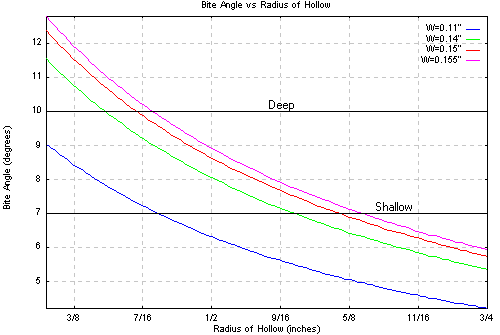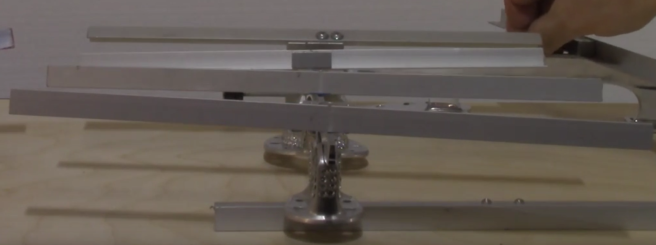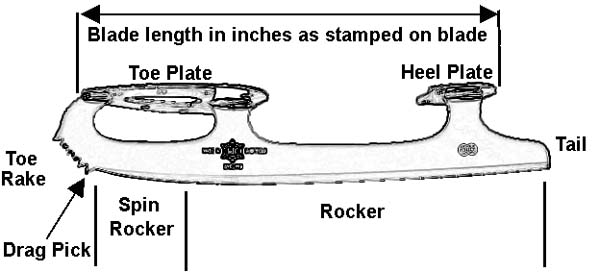When you buy your skating blades for the first time, you should have them sharpened by a professional. Most manufacturers hand sharpen their figure blades, which introduces inconsistencies into the blade profile and design. (The exception when purchasing new blades are Paramount blades, which are machine-laser sharpened). There may be parts of the blade that don’t have the featured rocker profile, have uneven edges, or the depth is lacking (the blade feels flat). A good sharpener can fix these issues, and give you a good grind to skate with. Most come sharpened to 7/16″, which can be unforgiving for some skaters, and we will talk more about this later as to why.
You should also have your blades sharpened regularly. With  friction/contact with ice, as well as any off-ice surface (wear blade guards), the steel will begin to wear away, and you will lose your edge, and soon your blades will be flat*. A flatter blade makes maneuvers trickier to do. Therefore, ALL skates will eventually need sharpening. However, the higher the quality blade, the longer you can go between sharpenings, as there is more carbon content in the steel which makes for tougher blades (note, that John Wilson and MK’s entry blades are strengthened to the same standard as their high-end blades, but this doesn’t change the fact that low-end blades need more frequent sharpening).
friction/contact with ice, as well as any off-ice surface (wear blade guards), the steel will begin to wear away, and you will lose your edge, and soon your blades will be flat*. A flatter blade makes maneuvers trickier to do. Therefore, ALL skates will eventually need sharpening. However, the higher the quality blade, the longer you can go between sharpenings, as there is more carbon content in the steel which makes for tougher blades (note, that John Wilson and MK’s entry blades are strengthened to the same standard as their high-end blades, but this doesn’t change the fact that low-end blades need more frequent sharpening).
*the curvature remains, but the narrow sharp edges become wider.
Radius of Hollow (Rocker)
The main consideration as a customer, is how flat or sharp you want your blades to be. The grinding wheel is changed to accommodate for this trait. The radius of the grinding wheel affects how hollow the grind is, hence being known as ‘radius of hollow’, or the radius you want for your grind. The technician will adjust the radius on their machine to suit your needs.
Small Radius
- Results in a deep hollow
- Gives you more edge bite
= more time to fix jump landings (more secure edges)
= better edge maneuvers (e.g. crossovers) - More tight three-turns and faster spins (if you’re centered on the sweet spot)
- More drag/friction (slower to skate)
- More grip, which makes it harder to control the skates, leading to being:
- Harder to stop without chatter, or going over your skate
Larger Radius
- Results in a shallow hollow
- Gives you less edge
= less time to fix jump landings (more likely to slip after landing) - Less tight three-turns and slower spins (when centered on the sweet spot)
- Less drag/friction (faster to skate)
- Less grip on the ice, making it easier to maneuver on the ice

Most figure skates are 0.15″ wide, MK Phantoms are 0.155″ wide. The bite angle is the angle at which the edge meets the ice. Side-honed blades (Phantom, Gold Seal and Gold Star) will also give more bite on inside (and outside) edges, roughly 2 to 3 degrees extra. It’s actually this bite angle that gives the characteristics of edges being deep or shallow.
10 degree edge is very deep, and 7 degree edge is very shallow.
Recommendations
Light skaters (children) should have a deeper grind (smaller radii), because there would naturally be more edge on the blade, which is ideal for children and light skaters since they don’t need to dig into the ice as much to get a decent edge.
Heavier skaters (adults) should have a shallower grind (larger radii), because they can use their own weight to press down on the blades more, which results in deeper edge contact with the ice. Meanwhile, on a small radii, they would have a harder time to control the skates since they’re digging very deeply into the ice with their own weight already, and a deeper hollow grind will accentuate problems, making the heavier skater have to work harder to move on the ice due to experiencing more friction.
Professional skaters need a deep edge for landing triple/quadruple jumps, since they are afforded more time to fix their exit from a jump and secure their toe pick and edges (edge security). However, they will need to develop leg strength, especially as they get older, so that they can counteract the friction from having deeper edges.
Light skater (kids/petite frame): 7/16″ to 1/2″
Average weight: 1/2″ standard grind
Heavy skater (70kg or more): 1/2″ to 5/8″
(Side-Honed Blades: no less than 1/2″)
Sharpening Technicians’ Skills
There is more to sharpening than just the radius of hollow; let’s explore them.
Even Edges
Edges have to be even on both sides. There should not be a tilt to either side. Here is an example of a bad sharpen, where there are parts of the blade that are uneven.
Rocker is consistent
The glide rocker radius should be consistent all the way through. For example, a 7′ rocker could have parts along it that are 9′, 8′, 6′ etc, which makes for a bumpy rocker. In fact, when skates are purchased new, they can have these inconsistencies, as we briefly mentioned at the start. 
Sweet Spot is intact
Likewise, the spin rocker/sweet spot of the blade profile, should always be re-established with each sharpen. The sweet spot is the transition point where the curvature of the rocker changes, which is there to make spins and turns easier. An amazing number of sharpeners try to create a uniform rocker diameter. Unless they carefully re-establish the sweet spot profile when they sharpen, a few sharpenings will usually kill the sweet spot. This is because it only takes a few hundredths of an inch of metal to create a strong sweet spot. What you will feel is that you need more forward/back foot roll to go through it, and that there is a definite feel-able point there where the blade naturally and stably spins. Think of it as a very short length of the blade where there is a much smaller rocker diameter (sometimes called a spin rocker). [goldenskate.com] We explored sweet spots in an earlier post.
Trim the toe pick
After a number of sharpens, the drag pick will start to get in the way of being able to rock onto the sweet spot. Thus, a skilled technician should also realise when this happens, and should trim the drag pick down.
It only takes one bad sharpen to ruin the drag pick, sweet spot, or rocker of the blade. A good skate sharpener will be able to fix problems that may have been introduced by either the manufacturer or by a previous sharpening. However, the life of the blade is reduced with each sharpen as steel is shaved off, so it’s always a good idea to go to a skate sharpener that gets the job done in fewer passes of the grinding wheel.


